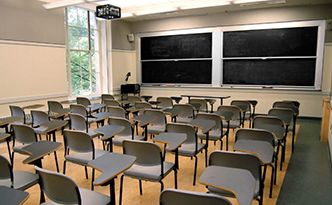Instructor Insights pages are part of the OCW Educator initiative, which seeks to enhance the value of OCW for educators.
Course Overview
This page focuses on the course 1.252J Urban Transportation Planning as it was taught Frederick Salvucci in Fall 2016.
This course examined the policy, politics, planning, and engineering of transportation systems in urban areas, with a particular focus on the Boston area. Transportation sustainability was a central theme throughout the course. The main goal was to elicit discussion, stimulate independent thinking, and encourage students to understand and challenge the conventional wisdom of transportation planning. The course was taught in standard lecture format with optional recitations.
Course Outcomes
Below, Frederick Salvucci shares his goals for student learning in the course.
I wanted students to learn to think about how to structure a problem related to urban transportation. How do you identify what the problem is? How do you identify the constituencies interested in the problem, and what their different points of view might be? I wanted them to think about how to generate potential solutions to problems and how to evaluate those solutions. I also wanted students to learn how to use simple numbers to quantify solutions, thus avoiding the trap of being directionally correct, but dimensionally insignificant, which is a common problem with policy and planning issues.
There are typically four assignments in (this course), and they almost always take students into Boston, Cambridge, and Somerville.
— Frederick Salvucci
Below, Frederick Salvucci describes various aspects of how he taught 1.252J Urban Transportation Planning.
Curriculum Information
Prerequisites
No prerequisites, but permission of the instructor required.
Requirements Satisfied
Can be applied toward multiple graduate degrees in Civil and Environmental Engineering and Urban Studies and Planning.
Offered
1.252J was offered every fall semester. Note: The course will not be offered at MIT in Fall 2017, but will be offered in Spring 2018 at the Harvard Graduate School of Design. MIT students can cross-register to take it there.
Student Information

Breakdown by Year
Mostly graduate students, with a few undergraduates
Breakdown by Major
- 1/2 Master of Science in Transportation candidates
- 1/2 Master in City Planning candidates
Typical Student Background
The students are usually in their first year of a master’s program, having graduated from a bachelor’s program, typically from an institution other than MIT. Sometimes we have a few international students.
Typically, some of the students possess significant work experience, but the majority do not. Most of the students have had only summer job-type work experience. There are usually a few who have worked for a few years before coming back for their master’s degree.
During an average week, students were expected to spend 12-14 hours on the course, roughly divided as follows:
Lecture
Met 1 time per week for 3 hours per session; 11 sessions total.
Recitation
Met during selected weeks for 2 hours per session; 5 sessions total; attendance optional.
Out of Class
Students completed assignments, went on a walking tour, and attended public meetings, hearings, lectures, and other events throughout the semester.
Semester Breakdown
| WEEK | M | T | W | Th | F |
|---|---|---|---|---|---|
| 1 |  |  |  |  |  |
| 2 |  |  |  |  |  |
| 3 |  |  |  |  |  |
| 4 |  |  |  |  |  |
| 5 |  |  |  |  |  |
| 6 |  |  |  |  |  |
| 7 |  |  |  |  |  |
| 8 |  |  |  |  |  |
| 9 |  |  |  |  |  |
| 10 |  |  |  |  |  |
| 11 |  |  |  |  |  |
| 12 |  |  |  |  |  |
| 13 |  |  |  |  |  |
| 14 |  |  |  |  |  |
| 15 |  |  |  |  |  |
| 16 |  |  |  |  |  |
 No classes throughout MIT
No classes throughout MIT Lecture
Lecture Everett/Sullivan/Charlestown walking tour
Everett/Sullivan/Charlestown walking tour No class session scheduled
No class session scheduled Recitation
Recitation Assignment due
Assignment due

 Room 1 of 1
Room 1 of 1 
 15%
15%  20% Participation
20% Participation